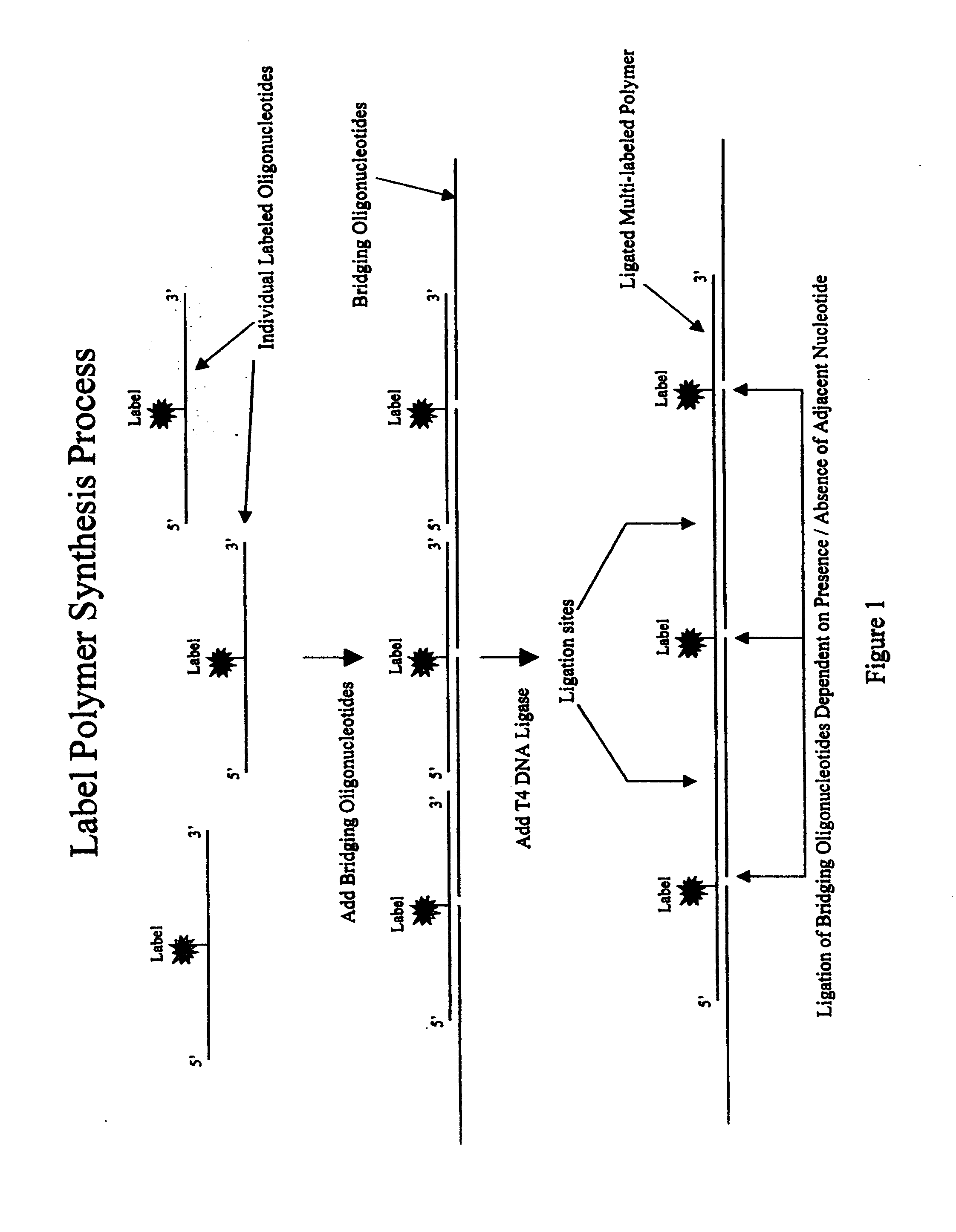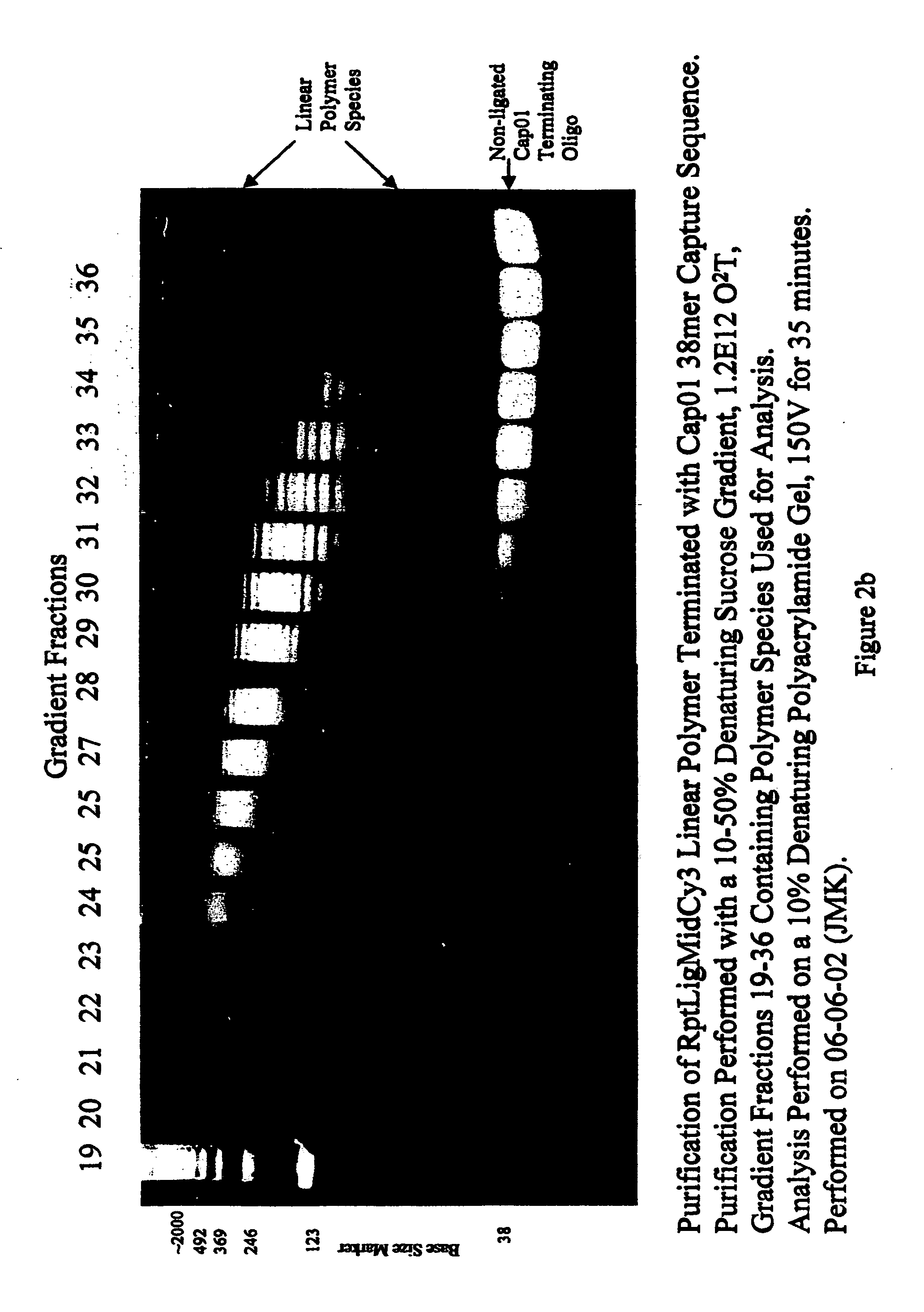Polymeric label molecules
- Summary
- Abstract
- Description
- Claims
- Application Information
AI Technical Summary
Benefits of technology
Problems solved by technology
Method used
Image
Examples
example 1
Synthesis of Multiple Labeled Polymer Labeled with Fluorescent Dye
[0102] Synthesis of a repeating polymeric DNA molecule containing multiple fluorescent dye labels was accomplished by using the following 15mer synthetic DNA oligonucleotide (synthesized by standard amidite chemistry methods), as the polymerizing component:
(SEQ. ID NO.1)5′- phos - ACg ggT C C(SE-Cy3) ATA TCT T -3′
The 5 prime end of the oligonucleotide is chemically (or enzymatically) phosphorylated and the eighth base of the oligo is a cytosine residue (C) containing a primary amine, which is subsequently labeled post oligonucleotide synthesis (and pre-polymerization) with a succinimydal ester containing fluorescent dye (in this example, Cyanine dye Cy3) in a standard chemical condensation reaction. This oligonucleotide is also referred to as “RptLigMidCy3”.
[0103] A bridging oligonucleotide capable of spanning the seven 5 prime nucleotides and seven 3 prime nucleotides of RptLigMidCy3 was synthesized utilizing st...
example 2
Synthesis of Multiple Labeled DNA Polymer with Non-Polymeric Oligonucleotides Capable of 3 Prime End or 5 Prime Ligation to the Labeled DNA Polymer in a Simultaneous Ligation Process
[0115] Addition of a second population of oligonucleotide sequences to serve as terminating oligonucleotides on either or both ends of the labeled polymers allows for the specific hybridization or binding of the polymeric molecules to a desired sequence. The complementary sequences can be used as capture sequences to hybridize to the complementary terminating sequence as discussed above. Uses of these constructs include direct primary targeting of nucleic acid molecules in a variety of hybridization platforms (including blots, microarrays, in-situ hybridization (ISH) and others). Alternatively or additionally, labeled polymers may provide secondary (or tertiary) labeling of primary targeting molecules by hybridizing the labeled polymers to sequence complementary to the labeled polymer bound terminating ...
example 3
Synthesis of Multiple Labeled Polymer with Non-Polymeric Sequence Specific Oligonucleotides Capable of 3 Prime End or 5 Prime Ligation to the Multiple Labeled Polymer in a Non-Simultaneous Pre-Priming Ligation Process
[0129] As previously noted in Example 2, simultaneous ligation of the termination oligo to the multiple labeled polymer can demonstrate poor efficiency if the termination oligo is used in excess. An alternative to that method that improves ligation efficiency requires the use of a bridging oligo that uniquely hybridizes to one end of the polymerizing oligonucleotide but not the other end; the other end is designed to specifically bind to the terminating oligonucleotide only, thereby allowing the specific ligation of the terminating oligonucleotide to a single polymerizing oligonucleotide only. This specific ligation reaction is performed as an initial “priming” reaction that creates a population of hybrid terminating and polymerizing oligonucleotide molecules that are ...
PUM
 Login to View More
Login to View More Abstract
Description
Claims
Application Information
 Login to View More
Login to View More - R&D
- Intellectual Property
- Life Sciences
- Materials
- Tech Scout
- Unparalleled Data Quality
- Higher Quality Content
- 60% Fewer Hallucinations
Browse by: Latest US Patents, China's latest patents, Technical Efficacy Thesaurus, Application Domain, Technology Topic, Popular Technical Reports.
© 2025 PatSnap. All rights reserved.Legal|Privacy policy|Modern Slavery Act Transparency Statement|Sitemap|About US| Contact US: help@patsnap.com



